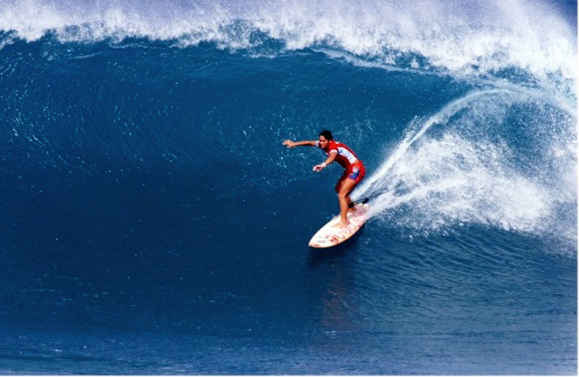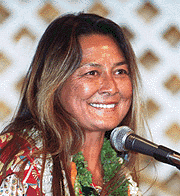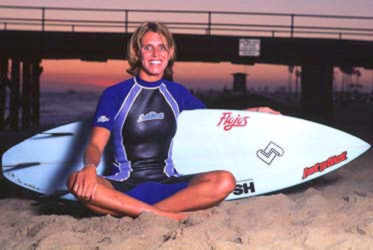| MORE SURFING PAGES | FEMALE SURFERS PAGE | ||
| KELLY SLATER PAGE | MALIBU SURF LEGENDS | ||
| SURF PHOTO GALLERY | SURFING'S DARK DAYS | ||
| MORE SURF HISTORY:SURFER GIRLS |

|
LEGENDARY WOMEN SURFERS During the Twentieth Century, males came to dominate the world of surfing almost to the exclusion of women. Toward the centurys end, this has been changing. Even so, few of us realize that surfings roots lay in an egalitarian surfing lifestyle. Although there were hierarchies in old time Polynesia and Hawaii, surfing was a common pursuit by not only males and females, but children as well. When one looks at the entire history of surfing during its approximate 5,000 year history, most of that time was spent with, yes, an admittedly male dominant role, but certainly not without the ever presence of kids and women. In that sense, the increasing modern day influence by female surfers can be seen more as a return to past balance, rather than just a new development. In the Hawaii of the late 1700s and early 1800s, European eye-witness descriptions referred to Hawaiian men, women and kids who rode smaller boards closer to shore. Except on those beaches where the most dangerous swells peaked or there was kapu (prohibited) against common use, men and women shared surfing areas equally. Historians Ben Finney and James Houston wrote that, "a large percentage of wahines of early Hawaii were skillful surfers, and sometimes champions. Early engravings of the sport are full of half-dressed island girls perched on surfboards at the top of a curling wave." Documenting this, Thomas Thrum published an article in 1896 entitled: "Hawaiian Surf Riding. In it, he wrote, "Native legends abound with the exploits of those who attained distinction among their fellows by their skill and daring in this sport, indulged in alike by both sexes; and frequently too -- as in these days of intellectual development -- the gentler sex carried off the highest honors." "This equality and sexual freedom," continued Finney and Houston, "added zest to the sport and was important to its widespread popularity. No doubt many an amorous Hawaiian, who didn't feel at all like surfing that day, found himself paddling for the breaker line in pursuit of his lady love, knowing full well that if a man and woman happened to ride the same wave together, custom allowed certain intimacies when they returned to the beach. More formal courtship was also carried out in the surf, when a man or woman tried to woo and win a mate by performing on the waves." The earliest female surfer we know of is Mamala and what we know crosses over into mythology. Mamala There is the shaking sea, the running sea of Kou, The crablike, moving sea of Kou. Prepare the awa to drink, the crab to eat. The small konane board is at Hono-kau-pu, My friend is on the highest point of the surf. There is a good surf for us. Ke-kai-o-Mamala, the ocean west of Waikiki off the coast of Honolulu, broke "straight out from a beautiful coconut grove... [at] Honoka`upu, wrote Finney and Houston, and provided some of the finest waves in Kou" -- what is now the harbor area of Hono-lulu. The break was named after Mamala, a famous surfer and a pominent O`ahu chiefess. She was a kupua, a demigod or hero with supernatural powers who could take the form of a beautiful woman, a gigantic lizard, or a great shark. According to legend, she was first married to another kupua, the shark-man Ouha. Mamala and Ouha would often drink awa together and played konane (pebble checkers) on the smooth konane stone at Kou. Mamala was an exceptional surfer. She liked to surf far out from shore, in rough seas, when the winds blew strong and whitecaps rolled in disorder into the bay of Kou. The people on the beach, watching her, would clap and yell in recognition of her skill. One day, the coconut grove chief Honoka`upu decided he wanted Mamala as his wife. Apparently, she was amenable and left Ouha to go live with her new husband. Feeling loss-of-face, Ouha got angry. First trying the belligerent approach, Ouha attempted to do Honoka`upu in, but was driven away. After this, the women of the area made fun of Ouha, ridiculing the god-man. Ouha could not handle the dishonor. Consequently, he cast off his human form forever and became the great shark god of the coast between Waikiki and Koko Head. Mamala was remembered ever afterward by the sea off Honolulu -- Ke-kai-o-Mamala -- and in a song about her triangular love affair -- the Mele (song) of Honoka`upu," part of which goes: From the top of the tossing surf waves, The eyes of the day and the night are forgotten. Kou is the day, and to-night The eyes meet at Kou. Kaneamuna In 1905, the oldest known papa he'e nalu (surfboard) was discovered at Ho‘okena, on the Kona coast of the Big Island. It was more like a paipo or bodyboard than surfboard. The board most likely belonged to Princess Kaneamuna, who lived during the early-to-mid 1600s. The board was discovered in a burial cave, along with a land toboggan or papa holua. These rare vehicles were described in "Sled of a Chieftess," in the December 8, 1905 issue of the Hawaiian Gazette, a popular semi-weekly Honolulu newspaper: "Her principal amusement was hee holua (coasting on a sled) and hee nalu (surfing). "She had her people make a sliding ground for her on a hill just back of the little village of Hookena, and ordered a sled… as well as a surfing board... When the slide was finished she passed many pleasant hours sliding down the steep hill. This slide was composed of smooth stones covered with rushes. After her death her sled and surf board disappeared, and the secret of their hiding-place was never revealed." Ka'ahumanu Kamehameha the Great (1753?-1819) and his favorite wife Ka'ahumanu (1768-1832) were both stoked surfers. According to Hawaiian historian John Papa Ii, they liked to surf Kooka, a break located at Pua`a, in north Kona, "where a coral head stands just outside a point of lava rocks. Ka'ahumanu was especially adept at lele wa`a, or canoe leaping. This is where a surfer leaped off an outrigger canoe, with surfboard, and then rode a wave into shore all in one motion. The canoe slid back of the wave because of the force of the shove given it with the feet. This was a difficult manouver, but for Kaahumanu and Kamehameha I it came naturally. Unfortunately, Ka'ahumanu's influence on the sport later grew detrimental, noted contemporary surf journalist Sam George. Widowed from Kamehameha and an early Christian convert, she [then] toured with Calvinist zealot Hiram Bingham. Kaiulaini "By 1900," Father of Modern Surfing Duke Kahanamoku told his biographer Joe Brennan, "surfing had totally disappeared throughout the Islands except for a few isolated spots on Kauai, Maui and Oahu, and even there only a handful of men took boards into the sea." The "handful" were virtually all males. A notable exception was Princess Kaiulaini who, "was an expert surfrider around 1895 to 1900," recalled early Twentieth Century surfrider Knute Cottrell. "She rode a long olo board made of wili wili and was the last of the old school at Waikiki."
Josephine Pratt & Mildred Turner The Waikiki Swimming Club was the first surf club to form, at the beginning of the Twentieth Century, when surfing's revival got underway. The Outrigger Canoe Club was the second. Other clubs that followed them included the Myrtles, Healanis and Hui Nalu. "There was a need for facilities to store boards, canoes, plus the availability of showers and dressing rooms with lockers," recalled Duke Kahanamoku. "To obtain official recognition for any records," wrote Joseph Brennan, "swimmers had to belong to a recognized club... Duke had concocted the name [Hui Nalu] when all were in a dilemma over finding one that would challenge the already-organized Healanis and Myrtles. Sitting on their boards off Waikiki one afternoon waiting for a rideable swell, Duke pointed seaward and said, 'The name of our club is out there.' He explained, 'The swells coming in spill into a hui (a gathering). And nalu (surf) is what we ride. See? Add them up and you get hui nalu -- the surf club!'" The Hui Nalu was officially organized in 1911 and included two outstanding women surfers, Mildred Ladybird Turner, and Josephine Jo Pratt. "Josephine Pratt was the best woman surfboard rider in the Islands during 1909-10 and 1911., wrote Tom Blake, who arrived in the Islands afterwards, but had gotten the word from others. She surfed Canoe, Queens and small first break." Dowsett Sisters & Leslie Lemon In Hawaiian Surfboard (later retitled Hawaiian Surfriders, 1935), Tom Blake noted that Duke Kahanamoku was the first one in recorded time to tandem ride a surfboard. "Leslie Lemon was the first to stand on Duke's shoulders, Blake added. Miss Marion 'Baby' Dowsett and Beatrice Dowsett were the two girls who first rode with Duke, three on the same board, the full length of Canoe surf. Isabel Letham While in Australia competing in swimming competition, Duke introduced surfing to Oz. On December 23, 1914, Duke gave a three hour demonstration at Freshwater Beach, riding on a pine board he made for that very occasion. He wrapped up his surfing exhibition with a demonstration of tandem surfing with a local girl, Isabel Letham. His tandem partner was only 15 years old at the time. Even so, Isabel Letham was already a locally-recognized and respected bodysurfer, aquaplanist and ocean swimmer. After four waves of going tandem with Duke, Isabel was hooked for life, she recalled. It was the most thrilling sport of all. While Duke went on to tour Australias eastern states and compete in swim meets, Isabel practiced her surfing. When Duke returned to Freshwater before returning to Hawai'i, she rode with him again, at an exhibition that was widely publicized. She was later inducted into the Australian Surfing Hall of Fame for the role she played in encouraging later Australian generations of women surfers. Beatrice Newport & The Waikiki Crew Tom Blake, amongst his many accomplishments, was also author of the first book strictly dedicated to surfing. In it, he wrote: "Among the best known at surfboard paddle racing since 1915 are: Beatrice Newport, Dot Hammond, Marchien Wehselau, Babe Gillespie, Olga Clark and Mildred Slaight." Later, by the beginning 1930s, Beatrice Newport had risen to top slot amongst the females surfing Waikiki. Miss Beatrice Newport was the best woman surfrider along about 1930, wrote Blake. Since her time no girl has come near to the mastering of surf-riding as she did except perhaps Cesily Cunha. I've never seen any girl ride the Kalehuawehe [the outermost reef]. [Marchien] Wehselau, [Dot] Hammond and [Babe] Gillespie were good women surfriders. Miss Frazier, a newcomer, is doing well." Mary Ann Hawkins & The SoCal Crew What kind of roles did women have in surfing? I asked John Doc Ball, surfing's first dedicated photographer, of what it was like surfing in Southern California in the 1930s. Mostly, he replied, if they had a boyfriend in it [surfing], they'd come down and eventually they'd say, Hey, let's get out in the water together. So, they'd have a tandem ride and finally started to get in the real deal. Surfing had revived in Hawai'i. On the Mainland, it was new and embraced by a limited number of watermen and some women -- like Mary Kerwin, Martha Chapin, Patty Godsave, Marion Cookie Cook, Dixie Scholes and Ann Kresge. Patty Godsave was one of the standout tandem surfers of the time. She used to ride tandem with one of the guys, Doc said, either Pete Peterson or E.J. Oshier. But the surfer that stood out the most among all the women was Mary Ann Hawkins. Mary Ann Hawkins Record 1933 -- SPAAU Record for 880-yard Freestyle Swim (new national junior record) 1936 -- AAU 500-meter Freestyle (winner) 1936 -- 880-yard Female Paddleboard Race, Ambassador Hotel Swim Team (winner) 1936 -- National Junior 880-yard Backstroke Champion 1936 1st ever all female paddleboard race. Mary Ann won 1st place. Same day, she won the half-mile swim. 1938-40 -- National Paddleboard Champion and Pacific Coast Women’s Surfboard Champion (Long Beach) 1st Female to enter the Catalina-Manhattan Beach Aquaplane Race 1939 won Women's Half-mile Swim and broke the 220-yard record for freestyle (Natatorium, Waikiki) 1970s By the 1970s, she had taught over 10,000 people to swim and had been a stunt double for many movie stars. Mary Ann Hawkins (1919-1993) was the greatest woman surfer of the first half of the Twentieth Century. Her record of competitive wins is evidence to that, as well as the respect of the women and men she surfed with. She was one of the first surfers down there at Palos Verdes Cove, Doc Ball attested of her surfing beginnings. There were women who could get to their feet on a board that their boyfriend built for them, remembered noted surfboard shaper Joe Quigg. But, as far as just going out and being a surfer on their own, Mary Ann stands out in my mind. She was an all around waterperson, big wave rider and oceanograher Ricky Grigg, noted, and I think it gave them [the women surfers who followed] a sense of depth. They had to be more than surfers. They had to be good bodysurfers and swimmers and just totally comfortable in the ocean. She was one of the best bodysurfers, man or woman, Joe Quigg acknowledged. She could get across (waves) at Malibu bodysurfing that most people couldn't get across on a surfboard. Featured in Doc Ball's California Surfriders 1946, then Mary Ann Hawkins rode the waves in the late 1930s and through the 1940s, afterwards becoming a stunt person for Hollywood. Mary Ann eventually moved to Hawai'i, where she started-up a swimming school for babies at the Hilton Hawaiian Village. The most prominent thing that comes to mind in speaking of Mary Ann, waterman Tommy Zahn once said, is that there have been great swimming ladies and great board surfing ladies [even so,] I haven't seen or heard of anybody with her versatility. End of the Wooden Board Era World War II technology ushered in the end of the wooden board era. The introduction of fiberglass and resin made it possible to encase lighter-than-redwood balsa boards in a protective case of polymer protection. Although polyurethane foam boards would not come into common use until the end of the 1950s, by the end of the 1940s, surfboards were already going through radical changes in materials and shapes. This revolution in surfboard design and construction would later make it possible for increasing numbers of women and men to get on board. Those of us who ride, today, owe much to those who went before those known and unknown, or just plain forgotten. Thanks to all of them, we can celebrate surfing's return to its roots where kids, women and men all share the ocean together as a major component in our lives. See you out there. Copyright © 1996-2000 by Malcolm Gault-Williams. All Rights Reserved. |

|
SURFING used to be considered a sport for men. Women were supposed to sit on the beach in revealing outfits and look pretty while they watched their daring boyfriends challenge the waves on surfboards. Rell Sunn, who died Friday at 47, helped to change that forever. Born in Makaha, she began to surf there at 4 and by 14 was entering surf meets. When meets had no category for women, she would compete with the men - and compete successfully. An expert swimmer, she became Hawaii's first female lifeguard. She helped organize the Women's Surfing Hui and the Women's Professional Surfing Association. In 1975 she founded the women's professional surfing tour. In 1982 she ranked first in the international professional surfing ratings. Stricken with breast cancer 14 years ago, she remained active in a variety of ways, working as a radio disc jockey and surf reporter, physical therapist at a Waianae care home and counselor at a cancer research center.
She became known as the "Queen of Makaha" for her efforts to teach children to surf and involvement in many community programs. Her Menehune Surf Meet for children has been an annual event for 23 years. She was also proficient at dancing the hula and playing the ukulele and was an accomplished diver and spearfisher. She was Hawaii's most outstanding women in water sports, called by one admirer a female counterpart of Duke Kahanamoku. Like Duke, she was a generous, cheerful person, despite her struggle with cancer. Fred Hemmings, another former surfing champion, said she "embodied everything that is great about surfing, but she grew larger than that. She represented the values we hold so dear in Hawaii. Rell was a giver, not a taker." She will be sorely missed, not only by the surfers and swimmers and the Makaha community she loved, but by all the people of Hawaii, even those who never got on a surfboard. |
| SURFER GIRLS OF THE 21ST CENTURY:THE NEW BREED |
| LAYNE BEACHLEY:THIS AUSSIE IS HOT AND NO.1 IN THE WORLD AND SHE SHREDS!!!!!! |

| MEGAN ABUBO:SHE'S NO.2 AND GETTING BETTER, FOLLOWING HAWAIIAN TRADITION |

| LISA ANDERSON:AMERICAN, OK? SHE'S AT NO.5 NOW BUT KNOWING LISA NOT FOR LONG |

| MELANIE BARTELS:NEW KID ON THE BLOCK WITH LOADS OF STYLE..... |

| JODIE NELSON:HOT PRO SURFER |


